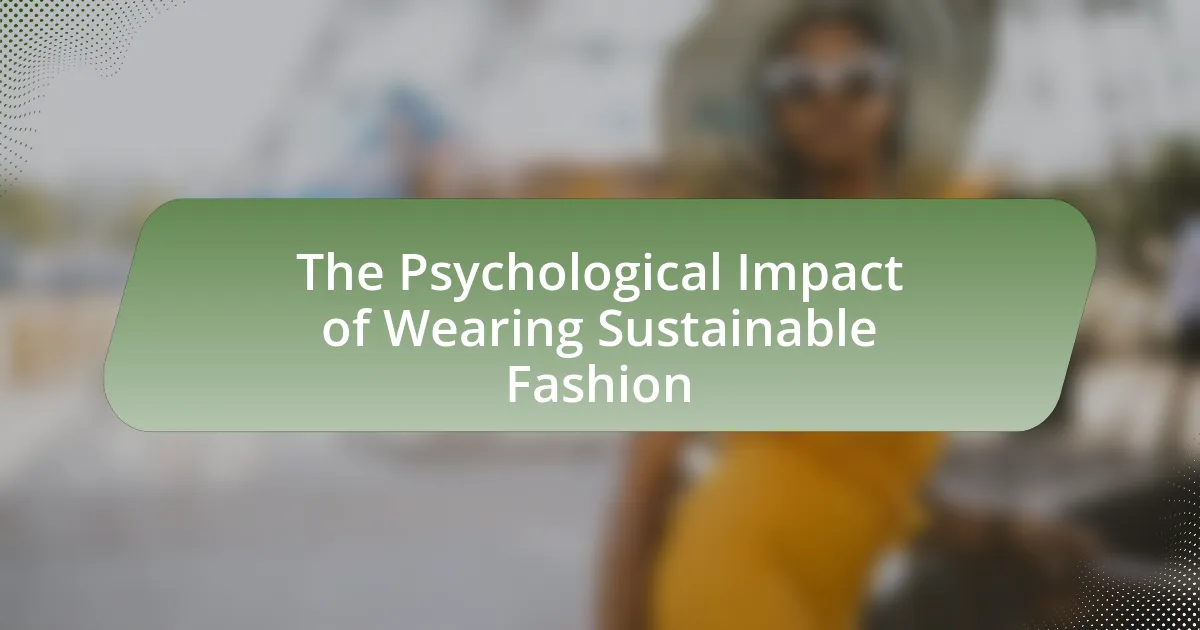The article explores the intersection of technology and sustainable fashion design, highlighting how innovative technologies such as 3D printing, digital textile printing, and blockchain are transforming the fashion industry towards more eco-friendly practices. It discusses the significant environmental challenges faced by the fashion sector, including excessive waste and pollution, and emphasizes the importance of adopting sustainable practices to mitigate these issues. Key technological advancements are examined for their roles in reducing resource consumption, enhancing supply chain transparency, and promoting ethical sourcing, ultimately contributing to a more sustainable and socially responsible fashion industry. The article also addresses the challenges brands face in integrating these technologies and the practical steps consumers can take to support sustainable fashion.

What is the Intersection of Technology and Sustainable Fashion Design?
The intersection of technology and sustainable fashion design involves the integration of innovative technologies to enhance eco-friendly practices in the fashion industry. Technologies such as 3D printing, digital textile printing, and blockchain are being utilized to reduce waste, improve supply chain transparency, and promote ethical sourcing. For instance, 3D printing allows for on-demand production, minimizing overproduction and waste, while blockchain technology provides traceability of materials, ensuring that they are sourced sustainably. According to a report by McKinsey & Company, the adoption of these technologies can significantly reduce the environmental impact of fashion, aligning with the industry’s shift towards sustainability.
How does technology influence sustainable fashion design?
Technology significantly influences sustainable fashion design by enabling innovative materials and processes that reduce environmental impact. For instance, advancements in textile recycling technologies allow for the transformation of post-consumer waste into new fabrics, thereby minimizing landfill contributions. Additionally, digital design tools, such as 3D modeling and virtual prototyping, streamline production processes, reducing waste and energy consumption. According to a report by McKinsey & Company, the adoption of digital technologies in fashion can lead to a 30% reduction in resource use. Furthermore, blockchain technology enhances transparency in supply chains, allowing consumers to make informed choices about the sustainability of their purchases. These technological advancements collectively contribute to a more sustainable fashion industry by promoting efficiency and reducing ecological footprints.
What technological innovations are currently shaping sustainable fashion?
Technological innovations currently shaping sustainable fashion include 3D printing, blockchain technology, and advanced textile recycling methods. 3D printing allows for on-demand production, reducing waste and overproduction, while blockchain technology enhances transparency in supply chains, enabling consumers to verify the sustainability of their purchases. Advanced textile recycling methods, such as chemical recycling, enable the transformation of post-consumer waste into new fibers, significantly reducing the environmental impact of fashion production. These innovations collectively contribute to a more sustainable fashion industry by minimizing waste, improving resource efficiency, and promoting ethical practices.
How do these technologies reduce environmental impact?
Technologies in sustainable fashion design reduce environmental impact by optimizing resource use and minimizing waste. For instance, digital pattern-making software decreases fabric waste by allowing precise cutting, which can reduce material consumption by up to 30%. Additionally, 3D printing technology enables on-demand production, significantly lowering overproduction and excess inventory, which are major contributors to landfill waste. Furthermore, the use of eco-friendly materials, such as recycled fibers and biodegradable textiles, directly decreases pollution and resource depletion associated with traditional manufacturing processes. These advancements collectively contribute to a more sustainable fashion industry by promoting efficiency and reducing the ecological footprint.
Why is sustainable fashion design important in today’s world?
Sustainable fashion design is important in today’s world because it addresses environmental degradation and promotes ethical practices within the fashion industry. The fashion industry is responsible for approximately 10% of global carbon emissions and significant water pollution, making sustainable practices essential for reducing its ecological footprint. By utilizing eco-friendly materials, reducing waste through innovative design, and ensuring fair labor practices, sustainable fashion contributes to a healthier planet and society. This approach not only meets consumer demand for responsible products but also aligns with global sustainability goals, such as the United Nations’ Sustainable Development Goals, which emphasize responsible consumption and production.
What are the environmental challenges faced by the fashion industry?
The fashion industry faces significant environmental challenges, including excessive water consumption, pollution from dyes and chemicals, and textile waste. For instance, the production of a single cotton t-shirt can require up to 2,700 liters of water, highlighting the industry’s strain on water resources. Additionally, the dyeing process contributes to water pollution, with an estimated 20% of global industrial water pollution stemming from textile treatment and dyeing. Furthermore, the industry generates approximately 92 million tons of waste annually, with a large portion ending up in landfills. These statistics underscore the urgent need for sustainable practices within the fashion sector to mitigate its environmental impact.
How does sustainable fashion contribute to social responsibility?
Sustainable fashion contributes to social responsibility by promoting ethical labor practices and reducing environmental impact. This approach ensures that workers are treated fairly, receive adequate wages, and work in safe conditions, which aligns with social equity principles. For instance, brands that adopt sustainable practices often source materials from suppliers who adhere to fair trade standards, thereby supporting local communities and economies. Additionally, sustainable fashion reduces waste and pollution, which benefits society by fostering a healthier environment. According to the Global Fashion Agenda’s 2021 report, sustainable practices can significantly lower carbon emissions and resource consumption, further reinforcing the social responsibility of the fashion industry.

What are the key technologies driving sustainable fashion design?
Key technologies driving sustainable fashion design include 3D printing, digital textile printing, and blockchain technology. 3D printing allows for the creation of garments with minimal waste, as it enables on-demand production and customization, reducing overproduction. Digital textile printing further enhances sustainability by using less water and energy compared to traditional dyeing methods, while also allowing for intricate designs without the need for harmful chemicals. Blockchain technology provides transparency in the supply chain, enabling consumers to trace the origins of materials and ensuring ethical sourcing practices. These technologies collectively contribute to a more sustainable fashion industry by minimizing environmental impact and promoting ethical practices.
How does 3D printing contribute to sustainable fashion?
3D printing contributes to sustainable fashion by enabling on-demand production, which reduces waste associated with overproduction. This technology allows designers to create garments and accessories with precision, using only the necessary materials, thus minimizing excess fabric and resource consumption. According to a study by the Ellen MacArthur Foundation, 3D printing can significantly lower the carbon footprint of fashion by reducing transportation emissions, as items can be produced closer to the consumer. Additionally, 3D printing facilitates the use of recycled materials, further promoting sustainability in the fashion industry.
What are the benefits of using 3D printing in fashion production?
The benefits of using 3D printing in fashion production include reduced waste, customization, and faster prototyping. 3D printing minimizes material waste by using only the necessary amount of material for each item, which is crucial in an industry known for its environmental impact. Additionally, it allows for high levels of customization, enabling designers to create unique pieces tailored to individual consumer preferences. This technology also accelerates the prototyping process, allowing designers to quickly iterate on designs and bring products to market faster. According to a study by the Massachusetts Institute of Technology, 3D printing can reduce material waste by up to 90% compared to traditional manufacturing methods, highlighting its potential for sustainable fashion practices.
How does 3D printing minimize waste in the fashion industry?
3D printing minimizes waste in the fashion industry by enabling precise production that aligns closely with design specifications, thereby reducing excess material usage. Traditional manufacturing often results in significant waste due to cutting and shaping processes that discard unused fabric. In contrast, 3D printing utilizes additive manufacturing techniques, where materials are added layer by layer, allowing for the creation of complex designs without the need for cutting away excess material. Research indicates that 3D printing can reduce material waste by up to 90% compared to conventional methods, as it only uses the material necessary for the final product. This efficiency not only conserves resources but also supports sustainable practices within the fashion industry.
What role does digital textile printing play in sustainability?
Digital textile printing significantly enhances sustainability in the fashion industry by reducing waste and resource consumption. Traditional textile printing methods often involve extensive water usage and generate substantial fabric waste due to the need for large print runs and the use of screens. In contrast, digital textile printing allows for on-demand production, which minimizes excess inventory and reduces the environmental impact associated with overproduction.
Moreover, studies indicate that digital printing can use up to 90% less water compared to conventional methods, as it eliminates the need for water-intensive processes like dyeing and finishing. This technology also enables the use of eco-friendly inks, further decreasing the ecological footprint of textile production. Thus, digital textile printing plays a crucial role in promoting sustainable practices within the fashion industry by optimizing resource efficiency and minimizing environmental harm.
How does digital printing reduce water and chemical usage?
Digital printing significantly reduces water and chemical usage by employing a direct-to-substrate method that minimizes waste. Unlike traditional printing methods, which often require extensive water for rinsing screens and cleaning, digital printing uses only the necessary amount of ink, resulting in less runoff and fewer chemicals needed for cleanup. Studies indicate that digital printing can reduce water consumption by up to 90% compared to conventional methods, as it eliminates the need for large quantities of water in the printing process. Additionally, digital printing technology allows for precise ink application, which further decreases the amount of chemicals used in the production process.
What are the advantages of on-demand production in fashion?
On-demand production in fashion offers significant advantages, primarily reducing waste and enhancing sustainability. This production model minimizes overproduction by creating items only when there is confirmed demand, which directly addresses the issue of excess inventory that often leads to unsold garments being discarded. According to a report by McKinsey & Company, the fashion industry generates approximately 92 million tons of waste annually, highlighting the critical need for more sustainable practices. Additionally, on-demand production allows for greater customization, enabling brands to cater to individual consumer preferences, which can lead to increased customer satisfaction and loyalty. This approach also fosters a more agile supply chain, allowing brands to respond quickly to market trends and consumer demands, ultimately improving efficiency and profitability.

How can brands effectively integrate technology into sustainable fashion design?
Brands can effectively integrate technology into sustainable fashion design by utilizing advanced materials, data analytics, and digital tools to enhance sustainability. For instance, brands can adopt biodegradable fabrics and recycled materials, which reduce environmental impact. Additionally, data analytics can optimize supply chains, minimizing waste and energy consumption. Technologies like 3D printing enable on-demand production, further decreasing overproduction and excess inventory. A study by McKinsey & Company highlights that implementing digital technologies can lead to a 30% reduction in resource use in the fashion industry, demonstrating the tangible benefits of such integration.
What strategies can brands adopt to leverage technology for sustainability?
Brands can adopt strategies such as implementing data analytics, utilizing blockchain technology, and embracing sustainable materials to leverage technology for sustainability. Data analytics enables brands to optimize supply chains, reducing waste and improving resource efficiency; for instance, companies like Zara use data to forecast demand accurately, minimizing overproduction. Blockchain technology enhances transparency in sourcing and production processes, allowing consumers to verify the sustainability of products, as demonstrated by brands like Everledger, which tracks the provenance of diamonds. Additionally, embracing sustainable materials, such as recycled fabrics and bio-based textiles, can be facilitated through innovations in textile technology, with companies like Adidas producing shoes from ocean plastic, showcasing a commitment to environmental responsibility.
How can data analytics improve supply chain transparency?
Data analytics can improve supply chain transparency by providing real-time insights into every stage of the supply chain process. By analyzing data from various sources, such as inventory levels, supplier performance, and logistics, companies can identify bottlenecks, track product origins, and monitor compliance with sustainability standards. For instance, a study by McKinsey & Company found that companies leveraging advanced analytics in their supply chains can achieve up to a 20% reduction in costs and a 30% improvement in service levels. This data-driven approach enables stakeholders to make informed decisions, fostering accountability and enhancing trust among consumers and partners in the sustainable fashion industry.
What are the best practices for implementing sustainable technologies?
The best practices for implementing sustainable technologies include conducting a thorough lifecycle assessment, integrating renewable energy sources, and prioritizing materials with lower environmental impact. Conducting a lifecycle assessment helps identify the environmental effects of a product from production to disposal, allowing designers to make informed decisions that minimize waste and resource consumption. Integrating renewable energy sources, such as solar or wind power, reduces reliance on fossil fuels and lowers carbon emissions during production processes. Prioritizing materials with lower environmental impact, such as organic cotton or recycled polyester, ensures that the resources used are sustainable and contribute to a circular economy. These practices are supported by research indicating that sustainable fashion can significantly reduce environmental footprints, as highlighted in the “Sustainable Fashion: A Systematic Review” published in the Journal of Cleaner Production, which emphasizes the importance of these strategies in the industry.
What challenges do brands face when adopting technology in sustainable fashion?
Brands face several challenges when adopting technology in sustainable fashion, primarily including high costs, lack of expertise, and integration issues. High costs associated with advanced technologies can deter brands from investing, as sustainable practices often require significant upfront capital. Additionally, many brands lack the necessary expertise to implement and manage new technologies effectively, leading to inefficiencies and potential failures in execution. Integration issues arise when attempting to incorporate new technologies into existing supply chains and processes, which can disrupt operations and create resistance among stakeholders. These challenges are supported by industry reports indicating that 70% of fashion brands cite cost as a primary barrier to adopting sustainable technologies, while 60% struggle with the technical know-how required for implementation.
How can brands overcome resistance to change in traditional practices?
Brands can overcome resistance to change in traditional practices by actively engaging stakeholders and demonstrating the benefits of innovation. Effective communication about the advantages of adopting new technologies, such as improved efficiency and sustainability, can help alleviate fears associated with change. For instance, a study by McKinsey & Company found that companies that prioritize stakeholder engagement during transitions are 70% more likely to succeed in implementing new practices. By providing training and support, brands can facilitate a smoother transition, ensuring that employees feel equipped and confident in adopting new methods.
What are the financial implications of investing in sustainable technologies?
Investing in sustainable technologies can lead to significant long-term financial benefits, including cost savings, increased market competitiveness, and access to new revenue streams. Companies that adopt sustainable technologies often experience reduced operational costs due to lower energy consumption and waste management expenses. For instance, a study by McKinsey & Company found that companies implementing energy-efficient technologies can save up to 30% on energy costs. Additionally, as consumer demand for sustainable products rises, businesses that invest in these technologies can capture a growing market segment, enhancing their brand value and customer loyalty. Furthermore, government incentives and subsidies for sustainable practices can offset initial investment costs, making it financially advantageous for companies to transition to sustainable technologies.
What practical steps can consumers take to support sustainable fashion design?
Consumers can support sustainable fashion design by choosing to buy from brands that prioritize eco-friendly materials and ethical production practices. By selecting clothing made from organic cotton, recycled fabrics, or biodegradable materials, consumers directly contribute to reducing environmental impact. Additionally, supporting brands that are transparent about their supply chains and labor practices fosters ethical standards in the industry. Research indicates that the fashion industry is responsible for 10% of global carbon emissions, highlighting the importance of consumer choices in mitigating climate change. Furthermore, participating in clothing swaps, buying second-hand, and properly recycling garments can significantly reduce waste, as the average consumer discards around 81 pounds of clothing each year. These actions collectively empower consumers to drive demand for sustainable practices in fashion.
How can consumers identify and choose sustainable fashion brands?
Consumers can identify and choose sustainable fashion brands by researching the brand’s transparency regarding their supply chain, materials, and production practices. Brands that prioritize sustainability often provide detailed information about their sourcing of organic or recycled materials, ethical labor practices, and environmental impact. For instance, certifications such as Global Organic Textile Standard (GOTS) or Fair Trade can serve as indicators of a brand’s commitment to sustainability. Additionally, consumers can utilize technology, such as apps that rate brands on sustainability criteria, to make informed choices. Studies show that 66% of consumers are willing to pay more for sustainable brands, highlighting the growing demand for transparency and ethical practices in fashion.
What role does consumer education play in promoting sustainable fashion?
Consumer education plays a crucial role in promoting sustainable fashion by informing individuals about the environmental and social impacts of their purchasing decisions. Educated consumers are more likely to choose sustainable brands, which can lead to increased demand for eco-friendly products. Research indicates that 66% of consumers are willing to pay more for sustainable brands, highlighting the influence of consumer awareness on market trends. By understanding issues such as fast fashion’s contribution to waste and pollution, consumers can make informed choices that support sustainable practices in the fashion industry.




